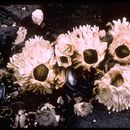Comprehensive Description
provided by Invertebrates of the Salish Sea
This sessile barnacle has 6 wall plates. The rostrum overlaps the wall plates on both sides of it. The tips of the terga form a slight beak when closed. The wall plates are composed of vertical tubelike ribs which, especially in the lower half, become downward-pointing fingerlike or thatchlike projections. The base is not heavily calcified so that, when the barnacle is broken off the rock, the base and some soft tissue remain attached to the rock. Wall plates white, brownish, gray, or greenish white. The cirri are almost black. Up to 6 cm diameter.
- license
- cc-by-nc-sa
- copyright
- Rosario Beach Marine Laboratory
Look Alikes
provided by Invertebrates of the Salish Sea
How to Distinguish from Similar Species: This is the only species locally that has the strong thatchlike external appearance. A bit farther south, Tetraclita rubescens has a similar appearance but it is a pinkish red color and has only 4 plates.
- license
- cc-by-nc-sa
- copyright
- Rosario Beach Marine Laboratory
Habitat
provided by Invertebrates of the Salish Sea
Attached to rocks, floats, or pilings. Not often found around fresh water. Especially common on steep shores with much current and waves in our area but on the open coast it is found in cracks and protected locations.
- license
- cc-by-nc-sa
- copyright
- Rosario Beach Marine Laboratory
Distribution
provided by Invertebrates of the Salish Sea
Geographical Range: Bering Sea to Morro Bay, Central California; Japan
- license
- cc-by-nc-sa
- copyright
- Rosario Beach Marine Laboratory
Comprehensive Description
provided by Invertebrates of the Salish Sea
Biology/Natural History: Farther south this species grows individually, but here in the Pacific Northwest aggregations can sometimes be so dense that the thatched appearance is not immediately evident. The barnacles grow very tall and narrow when densely aggregated. Competitors for space include Halichondria panicea, Mytilus trossulus, and Mytilus californianus. When the barnacles are small they may be bulldozed off the rocks by grazing limpets such as Lottia digitalis. The large size of adults likely protect them from some predators such as Nucella lamellosa or the seastars Pisaster ochraceous and Pycnopodia helianthoides. Eggs are brooded in the winter and the cyprid larvae settle in the spring. The larvae preferentially settle near adult barnacle shells. Lifespan up to 15 years. These barnacles appear to have been eaten by native tribes in SE Alaska in some coastal locations during an extended time period. At other times, mussels were a more common food in the same regions.
- license
- cc-by-nc-sa
- copyright
- Rosario Beach Marine Laboratory
Habitat
provided by Invertebrates of the Salish Sea
Depth Range: Mid intertidal to shallow subtidal. Especially common in the low intertidal, below the densest band of Balanus glandula and near Mytilus trossulus or M. californianus.
- license
- cc-by-nc-sa
- copyright
- Rosario Beach Marine Laboratory

